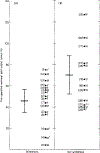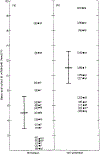Prospective study of the need for long-term antisecretory therapy in patients with Zollinger-Ellison syndrome following successful curative gastrinoma resection
- PMID: 8364130
- PMCID: PMC6736532
- DOI: 10.1111/j.1365-2036.1993.tb00095.x
Prospective study of the need for long-term antisecretory therapy in patients with Zollinger-Ellison syndrome following successful curative gastrinoma resection
Abstract
A long-term cure is now possible in more than 30% of selected patients with Zollinger-Ellison syndrome who undergo gastrinoma resection. The need, however, for continued gastric acid antisecretory therapy in these patients remains controversial. The current study was designed to determine whether post-operative antisecretory therapy is needed in patients who have undergone successful gastrinoma resection and, if so, to attempt to define criteria with which to identify patients who require therapy. Twenty-eight consecutive patients who had previously undergone curative gastrinoma resection were prospectively studied. When antisecretory therapy was discontinued, 43% (12/28) of these patients developed gastro-oesophageal reflux, diarrhoea, acid-peptic symptoms or endoscopic evidence of acid-peptic disease within 2 weeks and were deemed to have failed a trial of antisecretory drug withdrawal. The remaining 57% (16/28) of patients who successfully discontinued antisecretory therapy were followed for a mean time of 31 months after withdrawal of therapy. Analysis of acid output studies pre-operatively, as well as at the time of drug withdrawal, demonstrated that patients who were unable to discontinue antisecretory therapy exhibited higher pre-operative maximal acid output values and higher basal acid output values at the time of attempted drug withdrawal than patients who were able to discontinue therapy. Despite these findings, there was significant overlap in acid output values between groups so that it was not possible to define specific acid output criteria for successful drug withdrawal. Pre-operative clinical characteristics, such as the presence or absence of gastro-esophageal reflux or acid-peptic disease, or post-operative laboratory values, such as the fasting serum gastrin level, did not correlate with the ability to discontinue antisecretory therapy. We conclude that following successful curative gastrinoma resection, 40% of patients still require antisecretory therapy and that both symptom evaluation as well as upper endoscopy should be used to guide attempted drug withdrawal. Although patients who are not able to discontinue therapy have significantly higher acid output measurements than those who are able to discontinue therapy, neither acid output criteria nor any other laboratory or clinical characteristics are able to predict the need for continued antisecretory therapy in these patients.
Figures


Similar articles
-
Effects of curative gastrinoma resection on gastric secretory function and antisecretory drug requirement in the Zollinger-Ellison syndrome.Gastroenterology. 1992 Mar;102(3):767-78. doi: 10.1016/0016-5085(92)90157-t. Gastroenterology. 1992. PMID: 1537514 Clinical Trial.
-
Long-term treatment with lansoprazole for patients with Zollinger-Ellison syndrome.Aliment Pharmacol Ther. 1996 Aug;10(4):507-22. doi: 10.1046/j.1365-2036.1996.10152000.x. Aliment Pharmacol Ther. 1996. PMID: 8853754 Clinical Trial.
-
A prospective study of perioperative and postoperative control of acid hypersecretion in patients with Zollinger-Ellison syndrome undergoing gastrinoma resection.Surgery. 1988 Dec;104(6):1054-63. Surgery. 1988. PMID: 2904182
-
Omeprazole. A preliminary review of its pharmacodynamic and pharmacokinetic properties, and therapeutic potential in peptic ulcer disease and Zollinger-Ellison syndrome.Drugs. 1986 Jul;32(1):15-47. doi: 10.2165/00003495-198632010-00002. Drugs. 1986. PMID: 3527658 Review.
-
Treatment of patients with Zollinger-Ellison syndrome.Clin Ther. 1993;15 Suppl B:22-31. Clin Ther. 1993. PMID: 8205592 Review.
Cited by
-
Pharmacology of acid suppression in the hospital setting: focus on proton pump inhibition.Crit Care Med. 2002 Jun;30(6 Suppl):S356-61. doi: 10.1097/00003246-200206001-00003. Crit Care Med. 2002. PMID: 12072661 Free PMC article. Review.
-
Gastrinomas: Medical or Surgical Treatment.Endocrinol Metab Clin North Am. 2018 Sep;47(3):577-601. doi: 10.1016/j.ecl.2018.04.009. Endocrinol Metab Clin North Am. 2018. PMID: 30098717 Free PMC article. Review.
-
Long-Term Proton Pump Inhibitor-Acid Suppressive Treatment Can Cause Vitamin B12 Deficiency in Zollinger-Ellison Syndrome (ZES) Patients.Int J Mol Sci. 2024 Jul 2;25(13):7286. doi: 10.3390/ijms25137286. Int J Mol Sci. 2024. PMID: 39000391 Free PMC article.
-
Serum gastrin in Zollinger-Ellison syndrome: I. Prospective study of fasting serum gastrin in 309 patients from the National Institutes of Health and comparison with 2229 cases from the literature.Medicine (Baltimore). 2006 Nov;85(6):295-330. doi: 10.1097/01.md.0000236956.74128.76. Medicine (Baltimore). 2006. PMID: 17108778 Free PMC article.
-
Successful Lifetime/Long-Term Medical Treatment of Acid Hypersecretion in Zollinger-Ellison Syndrome (ZES): Myth or Fact? Insights from an Analysis of Results of NIH Long-Term Prospective Studies of ZES.Cancers (Basel). 2023 Feb 21;15(5):1377. doi: 10.3390/cancers15051377. Cancers (Basel). 2023. PMID: 36900170 Free PMC article.
References
-
- Jensen RT, Gardner JD. Zollinger-Ellison syndrome : clinical presentation, pathology, diagnosis and treatment In: Zakim D, Dannenberg A, eds. Peptic ulcer and other acid-related diseases. New York: Spectrum, 1991; 117–212.
-
- Norton JA, Jensen RT. Unresolved surgical issues in the management of patients with Zollinger-Ellison syndrome. World J Surg 1991; 15: 151–9. - PubMed
-
- Thompson NW Discussion of paper by Fraker D, Norton JA, Saeed Z, Maton PN, Gardner JD, Jensen RT. Surgery 1988; 104: 1063. - PubMed
-
- Pisegna JR, Norton JA, Slimak GG, et al. Effects of curative gastrinoma resection on gastric secretory function and antisecretory drug requirements in the Zollinger-Ellison syndrome. Gastroenterology 1992; 102: 767–78. - PubMed
MeSH terms
Substances
Grants and funding
LinkOut - more resources
Full Text Sources

